High-Speed Optical Shutter/Switch
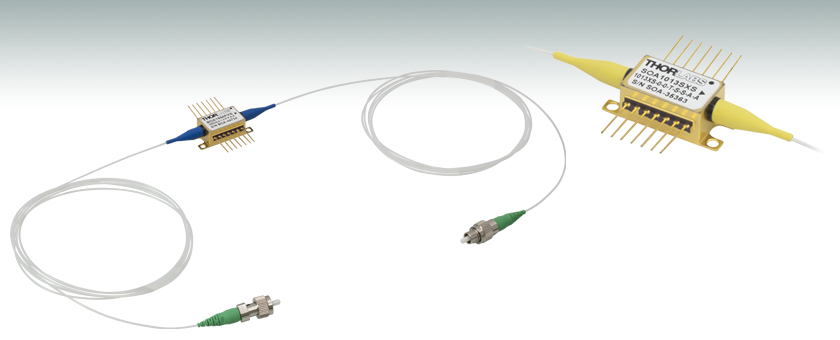
- Polarization-Dependent and Independent Versions
- High Fiber-to-Fiber Gain
- Off-State Isolation: >40 dB
BOA1550PXS
Polarization-Dependent Optical Shutter/Switch
SOA1013SXS
Polarization-Independent Optical Shutter/Switch
Close-Up of Butterfly Package

Please Wait
| Specificationsa | |||
|---|---|---|---|
| Item # | BOA1004PXS | BOA1550PXS | SOA1013SXS |
| Operating Wavelength | 1500 - 1600 nm | - | 1528 - 1562 nm |
| ASE Center Wavelength | - | 1550 nm | - |
| Optical Isolation (PIN / POUT) @ 0 mAb | ≥40 dB | ≥40 dB | ≥42 dB |
| Extinction Ratio @ PIN = -20 dBmb | 70 dB | 70 dBc | 60 dB |
| Switching Speed | 1 ns | 1 ns | 1 ns |
| Max Output Power for CW Input Signal | 18 dBm | 21 dBmb | 17 dBm |
| Max Output Power for Modulated Input Signal |
10 dBm | See Footnote d | 9 dBm |
| Small Signal Gain @ PIN = -20 dBm | 25 dBe | 27 dBb,c | 13 dBe |
Features
- High Switching Speed of 1 ns (Typ.)
- 1550 nm Wavelength Operation
- Polarization-Dependent and Independent Versions
- Fiber Pigtails with FC/APC Connectors
- Case Temperature Control via Internal Thermoelectric Cooler (TEC) Element
Thorlabs' High-Speed Optical Shutters/Switches are designed specifically for applications requiring an optical shutter with operation around 1550 nm. All our optical switches provide an extinction ratio greater than 60 dB. The devices are based on our semiconductor amplifier platform consisting of a highly efficient InP/InGaAsP Multiple Quantum Well (MQW) layer structures grown on an InP wafer and processed into a proven and reliable ridge waveguide. The device can operate as a lossless, high-speed, optical isolation switch, a full-range variable optical attenuator (VOA), or an optical shutter for protection of delicate optical equipment.
Mount and Driver Options
These butterfly packages are compatible with the CLD1015 laser diode mount with integrated controller and TEC, however, this controller will only be able to achieve switching speeds of around 4 µs. They are also compatible with the LM14TS and LM14S2 mounts, which can be used with our laser diode, TEC, and combined current/TEC controllers. When operating these lasers in environments with more than 5 °C variation in temperature, we recommend using the LM14TS mount, which provides active control of the butterfly package's case temperature to stabilize the amplifier's output wavelength and power. For information on compatible drivers that can achieve switching times up to the specified 1 ns time scale, please contact Tech Support.
Polarization-Dependent Optical Shutters/Switches
| Item # | BOA1004PXS | BOA1550PXSa | ||||
|---|---|---|---|---|---|---|
| Parameter | Min | Typical | Max | Min | Typical | Max |
| Operating Current (IOP) | - | 600 mA | 750 mA | - | 900 mA | 950 mA |
| Operating Wavelength | 1500 nm | - | 1600 nm | - | - | - |
| ASE Center Wavelength | - | - | - | 1530 nm | 1550 nm | 1580 nm |
| Optical 3 dB Bandwidth | - | - | - | 95 nm | 105 nm | - |
| Optical Isolation (PIN/POUT) @ 0 mA and 1550 nm | 40 dB | - | - | 40 dB | - | - |
| Extinction Ratio (On/Off @ PIN = -20 dBm and 1550 nm) | - | 70 dB | - | - | 70 dBb | - |
| Switching Speed | - | 1 ns | - | - | 1 ns | - |
| Max Output Power for CW Input Signal | - | 18 dBm | - | - | 21 dBmc | - |
| Max Output Power for Modulated Input Signal | - | 10 dBm | - | - | See Footnote d | - |
| Saturation Output Power (@ -3 dB) | 13 dBm | 15 dBm | - | 17 dBmb,c | 18 dBmb,c | - |
| Noise Figure | - | 8.0 dB | 9.5 dB | - | 8.5 dBb,c | 9.5 dBb,c |
| Small Signal Gain (@ PIN = -20 dBm) | 22 dBe | 25 dBe | - | 24 dBb,c | 27 dBb,c | - |
| Forward Voltage | - | 1.6 V | 1.8 V | - | 1.6 Vb | 2.1 Vb |
| Chip Length | - | 1.5 mm | - | - | 1.5 mm | - |
| Waveguide Refractive Index | - | 3.2 | - | - | 3.2 | - |
| Thermoelectric Cooler (TEC) Operation (Typical/Max @ TCASE = 25 °C/70 °C) | ||||||
| TEC Current | - | 0.23 A | 1.5 A | - | 0.55 A | 1.5 A |
| TEC Voltage | - | 0.5 V | 4 V | - | 0.70 V | 4.0 V |
| Thermistor Resistancef | - | 10 kΩ | - | - | 10 kΩ | - |
| Absolute Maximum Ratingsg | ||||||
| Operating Current | - | - | - | - | - | 950 mA |
| Optical Output Power, CW | - | - | - | - | - | 150 mW |
| Chip Temperature (TEC) | - | - | - | 10 °C | - | 30 °C |
| Case Temperature | - | - | - | 0 °C | - | 70 °C |
| Fiber Specifications | ||||||
| Type (PM Fiber) | Corning PMF-1550 | Corning PM15-U40A | ||||
| Mode Field Diameter | - | 10.5 ± 0.5 µm @ 1550 nm | ||||
| Numerical Aperture | - | 0.125 | ||||
| Length | 1.5 ± 0.1 m | 1.5 m | ||||
| Connector | FC/APC, Key Aligned to Slow Axis | |||||
Polarization-Independent Optical Shutter/Switch
| Item | SOA1013SXS | ||
|---|---|---|---|
| Parameter | Min | Typical | Max |
| Operating Current | - | 500 mA | 600 mA |
| Operating Wavelength | 1528 nm | - | 1562 nm |
| Optical Isolation (PIN/POUT) @ 0 mA and 1550 nm | 42 dB | - | - |
| Extinction Ratio (On/Off @ PIN = -20 dBm and 1550 nm) | - | 60 dB | - |
| Switching Speed | - | 1 ns | - |
| Max Output Power for CW Input Signal | - | 17 dBm | - |
| Max Output Power for Modulated Input Signal | - | 9 dBm | - |
| Saturation Output Power (@ -3 dB) | 12 dBm | 14 dBm | - |
| Noise Figure | - | 8.0 dB | 9.5 dB |
| Small Signal Gain Across Bandwidth (@ PIN = -20 dBm) | 10 dB | 13 dB | - |
| Polarization Dependent Gain | - | 1 dB | 1.8 dB |
| Forward Voltage | - | 1.6 V | 1.8 V |
| Chip Length | - | 1.5 mm | - |
| Waveguide Refractive Index | - | 3.2 | - |
| Thermoelectric Cooler (TEC) Operation (Typical/Max @ TCASE = 25 °C/70 °C) | |||
| TEC Current | - | 0.23 A | 1.5 A |
| TEC Voltage | - | 0.5 V | 4 V |
| Thermistor Resistancea | - | 10 kΩ | - |
| Fiber Specifications | |||
| Type (SM Fiber) | SMF-28-J9 | ||
| Length | 1.5 ± 0.1 m | ||
| Connector | FC/APC | ||
Calculated Thermistor Resistance

Click to Enlarge
This is plotted using the Steinhart-Hart equation,
where A = 1.129241 x 10-3, B = 2.341077 x 10-4, and C = 8.775468 x 10-8.
Note: All plots illustrate typical performance, and individual units may have slightly different performance, within the parameters outlined on the Specs tab.
BOA1004PXS Graphs

Click to Enlarge
Click Here for Raw Data
Typical gain versus output power plot for the BOA1004PXS optical switch/shutter at 600 mA.
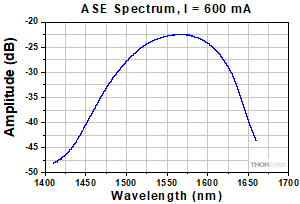
Click to Enlarge
Click Here for Raw Data
Typical ASE spectrum plot for the BOA1004PXS optical switch/shutter at 600 mA.
BOA1550PXS Graphs

Click to Enlarge
Click Here for Raw Data
Typical ASE spectrum plot for the BOA1550PXS optical switch/shutter at 900 mA.

Click to Enlarge
Click Here for Raw Data
Typical ripple spectrum plot for the BOA1550PXS optical switch/shutter at 900 mA.

Click to Enlarge
Click Here for Raw Data
Typical gain versus output power plot for the BOA1550PXS optical switch/shutter at 900 mA.
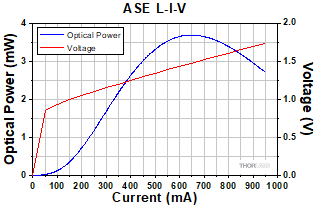
Click to Enlarge
Click Here for Raw Data
Typical ASE LIV plot for the BOA1550PXS optical switch/shutter.
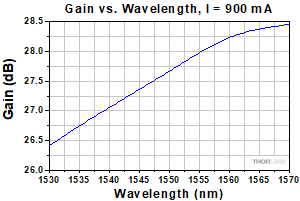
Click to Enlarge
Click Here for Raw Data
Typical gain versus wavelength plot for the BOA1550PXS optical switch/shutter at 900 mA.
SOA1013SXS Graphs

Click to Enlarge
Click Here for Raw Data
Typical gain versus power plot for the SOA1013SXS optical switch/shutter at 500 mA.

Click to Enlarge
Click Here for Raw Data
Typical gain versus wavelength plot for the SOA1013SXS optical switch/shutter at 500 mA.

| Posted Comments: | |
Sakees Chidambaram
(posted 2023-03-01 14:48:12.61) Hello,
We are using SOA1013SXS for one of our applications, and from a few days back, we are seeing abnormal functioning of the SOA. We are not getting any optical output from SOA, and when probed at the electrical input to SOA, it seems the SOA is not pulling any current from the driver circuit.
We also tested SOA using a standard LD controller (ITC4001), but we are not able to power on the SOA (the controller is throwing an error - 'of voltage tripping').
Please help us in verifying the functionality of SOA, if there there is a way. thanks. Wookjin Jeong
(posted 2022-03-21 15:20:13.32) Dear Thorlabs.
I have a question about spec sheet.
Is the maximum optical input to BOA1004XPS is 3dBm? or can I use more high input?
(I use it to make pulse light around 100 ns pulse width, 1 kHz. And the input optical light is CW light.)
Thank you
Wookjin cdolbashian
(posted 2022-03-25 02:55:50.0) Thank you for reaching out to us Wookjin. This is a good question as the presentation of this data can be a bit confusing. These devices do not really have a hard cutoff for input power, but will have attenuated performance as the input power is increased. To determine the input power from the "gain vs. output power" graph in the "graphs" tab, simply subtract the X axis (output power) from the Y axis (Gain), and the resulting value in dBm will be the input power. Note that beyond a certain input power (after gain), there is a sharp falloff for the gain. Daniel Ceballos-Herrera
(posted 2021-04-10 20:52:39.81) Dear Mr/Mrs, I am interested to purchase your High-Speed Optical Shutter/Switch SOA1013SXS. is it possible to directly modulating the SOA1013SXS with square electrical pulses of 10ns (or 100 ns) with a frequency rate of 100Khz, with a switching speed of 1ns and extintion ratio of 60dB?. It is for a acoustic sensing system. What (temperature and current) driver do you recommend for this application. The CLD1015 driver is adequated for my case?
Thank you very much in advance for your help,
Best regards,
Daniel Ceballos
National Autonomous University of Mexico - UNAM YLohia
(posted 2021-04-14 10:12:39.0) Hello Daniel, yes, this can be achieved using the SOA1013SXS. Unfortunately, we don't offer a high speed driver to support such fast rates at the moment. We have reached out to you directly with more information. Peter Holl
(posted 2020-07-07 03:36:45.987) These sound fantastic, but for our application we need a 780 nm version as well. Is there any roadmap as to when versions for other wavelengths will be available? YLohia
(posted 2020-07-07 11:40:56.0) Hello, thank you for your interest in our products. We are currently working on a 780 nm BOA. I have reached out to you directly to gather more details about your application. Jeffrey Lee
(posted 2019-05-08 14:45:32.847) I just wanted to let you know that if these could be made to work at 780nm (and other common wavelengths for atomic physics), I and a lot of my colleagues would be very very interested in them. YLohia
(posted 2019-05-08 02:56:30.0) Hello, thank you for contacting Thorlabs. I have reached out to you directly to discuss the possibility of offering this. marco.brunero
(posted 2018-11-12 10:09:14.437) Dear Mr/Mrs,
is it possible to directly modulating the
SOA1013SXS with electrical pulses of 10 ns and repetition rate of 20 us?
If the input CW signal will have a power of few milliwatts, what will be the maximum peak power of the output pulses?
Thank you,
Marco Brunero. YLohia
(posted 2018-11-12 08:56:14.0) Hello Marco, thank you for contacting Thorlabs. It is possible to directly modulate this SOA with such pulses, provided that the proper drive electronics are utilized. The output power depends on the wavelength, peak current, and input power. I will reach out to you directly to discuss this further. hnguyen43
(posted 2018-05-07 08:13:50.987) Would this product work for the wavelength 1130 nm range? If not, can I get a customized one for that wavelength? YLohia
(posted 2018-05-07 11:37:37.0) Hello, thank you for contacting Thorlabs. I will reach out to you directly regarding the possibility of offering this. marian.kreyer
(posted 2017-10-04 10:52:29.123) We would like to use this product as a shutter in an automatic power loss protection for our fiber amplifier.
Can you tell me a bit more about the properties of the input signal?
Do i need the TEC element when i operate it as a shutter?
What is the expected delay of the shutter?
Thanks in advance! tfrisch
(posted 2017-12-06 01:15:36.0) Hello, thank you for contacting Thorlabs. The internal TEC should be used, yes. The switching speed is 1ns, but if you want to use this as a shutter failsafe, the control electronics would likely be the limiting factor of the speed. For example CLD1015 would achieve only 4us. We will reach out to you directly to discuss the details your application and the input signal. brad.m.gibson
(posted 2016-12-14 17:35:47.78) Would it be possible to get a unit centered near 1391 nm? tfrisch
(posted 2016-12-19 04:07:46.0) Hello, thank you for contacting Thorlabs. I will reach out to you directly on the availability of a 1391nm version. felix.schmieder
(posted 2016-12-07 17:39:16.043) Like one of the previous posters I find this is a very interesting product. However, an operation at 532nm would be crucial to my application. tfrisch
(posted 2016-12-15 09:53:40.0) Hello, thank you for contacting Thorlabs. I will reach out to you directly about this. cong_du
(posted 2015-10-16 15:03:39.55) I will purchase your High-Speed Optical Shutter/Switch BOA1004PXS or SOA1013SXS
Do you provide optical switch driver with above switch so I can set up the time and speed/frequence of off-on switch freely ? besembeson
(posted 2015-10-27 05:25:49.0) Response from Bweh at Thorlabs USA: For low speed modulation (up to couple of hundred kHz), you can use our CLD1015. We don't have suitable driver at this time for high-speed switching. I will follow-up with some possible external suggestions. dangerous46
(posted 2015-02-18 18:25:26.64) Is this product capable of acting as a high extinction ratio modulator? The application I am interested in will cycle on/off up to a rate of 100 MHz. jlow
(posted 2015-02-25 03:15:03.0) Response from Jeremy at Thorlabs: You can use this to switch on/off an optical signal quickly. I will contact you directly to discuss more about your application. user
(posted 2014-03-29 09:41:21.71) This looks like a very nice product. Like the other commenters in the feedback section, I would also be interested in seeing a similar device with such fast switching times, but at a different wavelength, 532nm. jlow
(posted 2014-03-31 04:31:58.0) Response from Jeremy at Thorlabs: Thank you for providing your feedback regarding this. I have added this additional request in our internal forum and we will look into this possibility. biver
(posted 2012-12-04 08:21:12.973) Hello,
I would like to know if the same device is available for UV wavelength!
I am working with a fast UV pulsed laser (wavelength: 343nm; repetition rate: 200kHz-2MHz; beam size: ~3mm) and want to be able to discriminate between pulses. The idea is to have a sequence of 3 pulses, the first acting as a trigger to open a shutter and let the 2 following pulses pass (the first pulse triggers also an imaging system to visualize the impact of the 2 pulses on a given substrate). Mechanical shutters seem to be too slow for this application, and I am considering using an optical shutter, a Pockels cell or an acousto-optic modulator.
Thank you in advance,
Emeric Biver tcohen
(posted 2012-07-03 10:56:00.0) Response from Tim at Thorlabs: The semiconductor optical amplifiers (SOAs/BOAs) that we currently provide are all single-mode devices. The optical amplifier semiconductor chip itself is a single-mode waveguide device. So, the input optical coupling efficiency to a multi-mode fiber would be very poor. We could make a multi-mode semiconductor optical amplifier chip and couple it to large-core, multi-mode fiber. This would work, however, multi-mode optical amplifiers have a higher noise figure than single-mode amplifiers (the noise figure is directly proportional to the number of modes). The noise figure may or may not be important depending on the application. roger.pilkington
(posted 2012-07-01 04:32:23.0) Can this be done for larger fibers as well. Such as a 200um core? bdada
(posted 2011-03-04 18:46:00.0) Response from Buki:
The semiconductor optical amplifier operates as a classic intensity amplifier, with a minimum theoretical noise figure of 3 dB. The statistics of the coherent stimulation process as well as the presence of spontaneous emission at the signal wavelength would make it impossible to be used with a single-photon input. A phase sensitive, parametric amplifier, which does not have spontaneous emission at the signal wavelength and can have 0 dB noise figure would be more appropriate for single photon.
In terms of wavelength range, our existing product lines covers from 1 um to 2 um. We are working on expanding to wavelengths shorter than 1 um. We will contact you directly to learn more about your wavelength needs. till.weinhold
(posted 2011-03-03 23:05:09.0) Two questions regarding the SOA1013SXS unit. Can it be operated with gated single photon inputs or does it require a minimum input power.
What is the loss through the system?
And any view to expanding the wavelength range?
Cheers
Till Adam
(posted 2010-05-13 10:32:33.0) A response from Adam at Thorlabs to Pascal: At this time, we do not work with the material system that would allow us to make a custom semiconductor optical amplifier at 670nm. Therefore, we cannot produce custom versions at this time. I will make a suggestion to our engineers for this customer inspired new product idea. I will contact you directly to find out your exact application. pascal.deladurantaye
(posted 2010-05-13 08:54:02.0) Could you provide a custom version that would work at 670 nm? |


Click to Enlarge
Click Here for Raw Data
The OFF state means the optical switch/shutter has no current flowing through the device, and the ON state means the optical switch/shutter has operating current. The input signal has a power of 3.5 dBm.
- High Extinction Ratio of 70 dB (Typ.)
- 1.5 m PM Fiber Pigtails with FC/APC Connectors with Key Aligned to Slow Axis
- Typical Applications: Cavity Ring-Down Sensors and LIDAR Systems
The BOA1004PXS and BOA1550PXS polarization-dependent switches offer the user full control of the power level making them ideal for high-power laser pulse generation systems like cavity ring-down sensors and LIDAR systems. The shutter performance is shown in the graph to the right. Each device comes in an industry-standard 14-pin butterfly package with polarization-maintaining (PM) fiber pigtails that are terminated with FC/APC connectors; the connector key is aligned to the slow axis. These switches can be customized upon request to have isolators on the input, output, or both. Please contact Tech Support for help customizing a device for your application.

- <1.8 dB Polarization-Dependent Gain
- 1528 - 1562 nm Operating Wavelength
- 1.5 m SM Fiber Pigtails with FC/APC Connectors
- Typical Applications: Pulsed Laser and LIDAR Systems
The SOA1013SXS polarization-independent switch features low polarization sensitivity, wide optical bandwidth, and high extinction ratio. Using the gain/absorption properties of the multiple quantum well structure, the device can function as an optical blocking shutter with no reflections. In addition, the switch is also designed to function reliably at signal levels of 15 dBm and above. The SOA1013SXS is also ideal for applications where the input signal polarization is unknown or fluctuates. The device comes in an industry-standard 14-pin butterfly package with single mode (SM) fiber pigtails that are terminated with FC/APC connectors.
 Products Home
Products Home








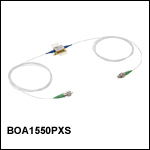
 Zoom
Zoom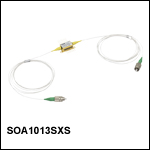
 High Speed Optical Shutter/Switch
High Speed Optical Shutter/Switch